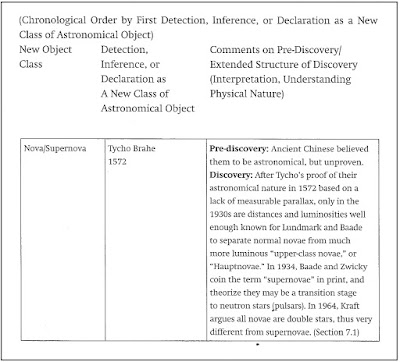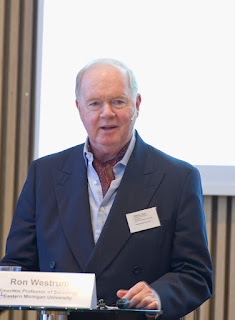The writing is direct, intended for the interested and educated general reader. I learned a lot, of course, though I did have some quibbles with the details of culture and sociology. Eventually, even after the problem was nominally solved, and the distances to some stars were directly measured, ten new uses were found for parallax.
The title of the book could be a metaphor for the history of astronomy. We tend to view the history of astronomy as if through one eye: the arrangement of the universe, from the geocentric model to the heliocentric model, to the understanding that our own Milky Way is not the universe, but just one of billions of galaxies. Viewing the history of astronomy through the other narrative eye of measuring the size and scale of the universe reveals the depth of the problem and of the geniuses who attempted to solve it.
Explaining Copernicus’s world of 1500, Hirshfeld writes: “Scholars communicated with one another freely, exchanging ideas that centuries earlier might have brought them to the stake.” In fact, the problem of Easter—identifying the first Sunday after the first full moon after the first day of spring—required reconciling the solar and lunar calendars. Using astrolabes and water clocks, Medieval astronomers knew that the geocentric model of Ptolemy required corrections. They had calculated the orbit of Saturn to be one billion miles from Earth and the stars immeasurably beyond that. That only reinforced the unimportance of worldly concerns and the grandeur of heaven. No one was burned at the stake in 1250 for worrying why the calendar was off by six hours, though they knew that it was.
To earn a baccalaureate degree at a Medieval university, you had to complete seven classes in the Liberal Arts. First were the trivium: Logic, Grammar, and Rhetoric. Following that were the quadrivium: Arithmetic, Geometry, Astronomy, and Music. Even today a liberal arts degree requires classes in mathematics and science, in addition to the humanities of language and fine arts.
“One issue that Ptolemy had to deal with was the patently nonuniform motions of certain celestial bodies. The Sun, for example, appears to move through the sky with varying speed depending on the time of year. Planets, too, appear to speed up and slow down as the months pass. But according to the writings of Aristotle, whose word was law in those days, heavenly bodies, in fact, move always at constant speed in circular orbits.” (page 24)
Aristotle’s word was not law. He was just one philosopher among many. Cicero was an educated Roman and he gave more attention to the Epicureans and Stoics than to the Peripatetics of the Aristotelean tradition. In any case, there was no legal enforcement of any theories of natural philosophy.
Looking back to the 12th century from the 21st century, Hirshfeld too easily collapses time, forgetting that decades mark lifetimes and a century envelopes three generations. He delivers a rich tapestry of evolving theory when he writes about astrophysics, yet he encapsulates ten lifetimes in the phrase “the Church of the Middle Ages” and fails to differentiate it from “the Church of the Counter-Reformation.”
There’s always a better approximation and it is interesting that one correction to Hirshfeld came 20 years later from his collaborating editor at the History of Astronomy Division of the American Astronomical Society. Writing about the star Eltamin or gamma Draconis, Hirshfeld explains: “The name Eltamin derives from Al Ras al Timmen, ‘the Dragon’s head’… The more prosaic designation Gamma is first encountered in the beautiful Uranometria sky atlas drawn by German celestial cartographer Johannes Bayer in 1603. In Bayer’s system, a constellation’s brightest star is labeled Alpha, the second brightest Beta, and so on.” (page 136). That is a common claim. It does leave us with problems, however.
Castor in Gemini is Alpha Geminorum but it is less bright than Pollux, which is Beta Geminorum. Other examples are easy to find. Some astronomers explain that the absolute magnitudes of stars can and do change over time.
In fact, the answer is that “… Bayer divided the sky into strips and then identified the brightest stars within them. …It was originally thought that the stars were assigned labels in alphabetical order according to their brightness. However, in many constellations the brightest star is labelled β, leading astronomers in the 18th century to speculate that many stars had changed in brightness from Bayer’s time. The 19th century German astronomer F. W. A. Argelander discovered that Bayer had used a north-to-south ordering system within magnitude bins.5 Once Bayer had run out of Greek letters, he switched to Latin letters.” [5: Babinger, F. 1915, “Johannes Bayer, des Begründer der neuzeitlichen Sternbenennung,” Archiv für die Geschichte der Naturwissenschaften und der Technik, 5, 108.] Cited in This Month in Astronomical History: September 2020, by Jason E. Ybarra, Bridgewater College.
https://aas.org/posts/news/2020/09/month-astronomical-history-september-2020
Of necessity, our macroscopic sense of place paralleled the discovery of the microscopic. The same lenses served both purposes. It is telling that Joseph Fraunhofer’s 1829 heliometer, the most exacting measuring telescope created up to that time, included a microscope for reading its extremely precise scale.
Science is an integration. Internally consistent theories explain observable facts. It is how we know anything. More to the point, facts and theories do not exist in isolation. Seeming contradictions must be resolved or eliminated. That speaks to the problem of parallax.
Herschel’s case, in particular, exemplified the exacting standards to which all scientists adhere. It can be hard to know when your very correct theory only awaits the predicted facts and when the discovered facts demand a new theory.
Like Galileo and the savants who followed, Herschel expected that all of the stars are more or less arrayed at random, that the universe is uniform. Thus, stars that appear to be close to each other are not physical companions. This led astronomers to seek pairs of stars, one much brighter than the other in the expectation that the brighter was the nearer of the two and thus a good candidate for measuring parallax. After years of searching with a behemoth reflector, Herschel announced on July 1, 1802, that many double stars are indeed gravitationally locked. As the problem of parallax was attacked over the centuries, the attempts revealed other truths. Foremost, perhaps, was that many stars are systems of doubles, triples, and sets of them.
Writing before 2001, Hirshfeld expected new measurements from missions that unfortunately were cancelled.
- DIVA: Double Interferometer for Visual Astrometry (uncertain)
- FAME Full-sky Astrometric Mapping Explorer was cancelled in 2002.
- SIM: Space Interferometry Mission was cancelled in 2010
- GAIA is a space observatory of the European Space Agency (ESA), launched in 2013 aboard a Soyuz and expected to operate until about 2022.
Gaia has been successful and its empirical results are the foundation of new theories. At the 52ndmeeting of the Division for Dynamical Astronomy of the AAS, held May 17-21, 2021, eleven papers cited Gaia data.
PREVIOUSLY ON NECESSARY FACTS
Rescuing Aristotle and the Church
The Map that Changed the World
















